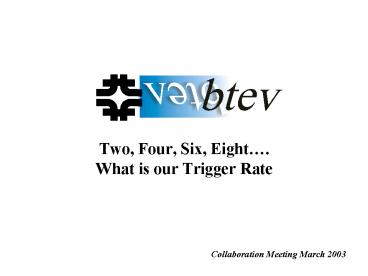Two, Four, Six, Eight PowerPoint PPT Presentation
Title: Two, Four, Six, Eight
1
Two, Four, Six, Eight.What is our Trigger Rate
- Collaboration Meeting March 2003
2
Roadmap
- The trigger group has been studying the
performance of various trigger - subsystems for different numbers of interactions
per beam crossing (ints/BCO), - in anticipation of possible questions from P5,
and I will summarize the results - L1 pixel trigger
- Results from the BTeV Proposal (May 2000)
- FPGA segment tracker
- DSP timing results
- L1 muon trigger
- L2 trigger
- Summary table
3
Level 1 hardware
The BTeV Pixel Trigger System
Switch
DSP Farm
FPGASegment Tracker
4
Level 1 hardware (cont.)
FPGA Hardware Studies (buffer needs timing)
5
How to speed up L1 code
- As described in Btev Proposal update Much of L1
algorithm optimization - work has focused on the segment matching
routine.Thecurrent version is - 8x faster than original
- However, as the previous slide shows, gt50 of
total L1 processing time is - still taken up by the segment matching
- HASH SORTER Simple and novel hardware solution
(Jin-Yuan Wu)
- sort inner and outer triplets into bins of
slope (non-bend view)
- attempt to match only inner/outer triplets
with similar slope
- will significantly reduce number of
combinations that need to be tried
- no physics cuts applied in hardware,
simply sorting triplets into bins
NEXT SLIDE test hash sorter idea with C-code
implementation
6
Test hash sorter idea
1.5-2x faster
4-5x faster
7
Hash sorter Q A
- Can this be implemented in hardware?
- YES !
- In fact, we have finished the design for a
Xilinx FPGA, and successfully compiled it
yesterday
- What changes need to be done to existing
pre-prototype hardware?
- NONE !
- The firmware will fit comfortably in Buffer
Manager FPGA of the existing pre-prototype
board
- Hash sorter takes up 10 of Buffer Manager
FPGA, while current Buffer Manager FPGA
utilization only 40
8
Trigger Summary
Current trigger results
PowerShow.com is a leading presentation sharing website. It has millions of presentations already uploaded and available with 1,000s more being uploaded by its users every day. Whatever your area of interest, here you’ll be able to find and view presentations you’ll love and possibly download. And, best of all, it is completely free and easy to use.
You might even have a presentation you’d like to share with others. If so, just upload it to PowerShow.com. We’ll convert it to an HTML5 slideshow that includes all the media types you’ve already added: audio, video, music, pictures, animations and transition effects. Then you can share it with your target audience as well as PowerShow.com’s millions of monthly visitors. And, again, it’s all free.
About the Developers
PowerShow.com is brought to you by CrystalGraphics, the award-winning developer and market-leading publisher of rich-media enhancement products for presentations. Our product offerings include millions of PowerPoint templates, diagrams, animated 3D characters and more.

